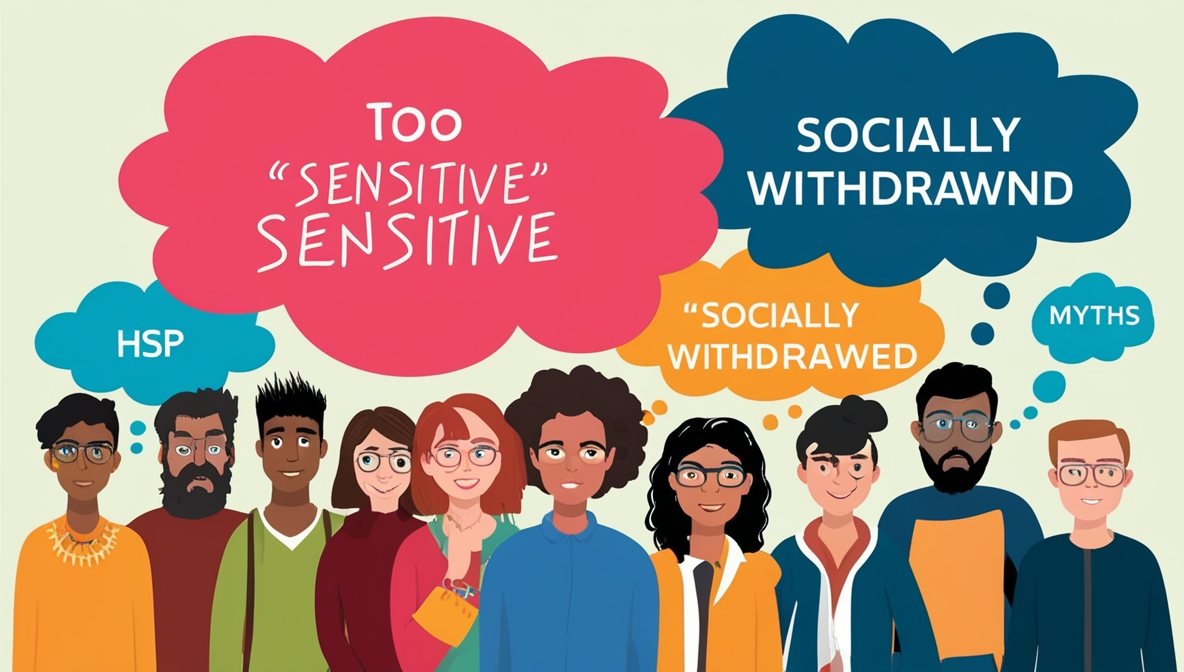Have you ever felt overwhelmed by loud noises or bright lights? Perhaps a sad or violent movie scene has a big impact on you. Maybe you’ve wondered if this intense sensitivity means there’s something different about you. As a highly sensitive person (HSP), these experiences are part of daily life, but what does it mean to be highly sensitive? And is there a connection to autism spectrum disorder (ASD)?
Imagine Sarah, a mother who recently noticed her son, Jake, reacting intensely to sensory input like loud noises and bright lights. Worried, she began researching and stumbled upon terms like sensory processing sensitivity (SPS) and autism spectrum disorder (ASD). Sarah’s journey into understanding her son’s behavior led her to question: Is HSP a type of autism?
Many people, like Sarah, grapple with understanding the distinct differences between high sensitivity and autism. It’s a topic that not only sparks curiosity but also deeply affects those trying to navigate their way through overwhelming sensory stimuli and emotional sensitivity.
In this article, we’ll explore whether being a highly sensitive person is a type of autism, delving into the sensory processing challenges and emotional intensity that characterize both conditions. By understanding these complexities, we can better support individuals like Jake and others who navigate the world with heightened sensitivity.
Section 1: Understanding HSP (Highly Sensitive Person)

Definition of HSP
What is HSP?
A Highly Sensitive Person (HSP) experiences heightened sensitivity to various forms of stimuli. This is often due to a personality trait known as sensory processing sensitivity (SPS). This heightened sensitivity can affect how the person perceives and responds to their environment, leading to stronger reactions to sensory input like noise, light, and textures.
Characteristics of HSP
HSPs often exhibit the following traits:
Heightened Sensitivity: They are more sensitive to sensory inputs such as bright lights, loud noises, and strong smells.
Emotional Intensity: They are more sensitive to emotional stimuli and can easily become overwhelmed.
Strong Reactions to Social Cues: HSPs are highly sensitive to other people’s emotions and are more susceptible to the effects of social interactions.
Reflective Nature: They think deeply about their experiences and are often very empathetic.
Easily Overwhelmed: Due to their heightened sensitivity, they can become overwhelmed in environments others might find normal.
Scientific Background
Research Studies on HSP
Research on HSPs has grown, with studies indicating that sensory processing sensitivity is a measurable and significant trait. Key findings from these studies include:
Genetic Basis: Evidence suggests that SPS is an inherited trait that can run in families.
Brain Function: Studies using brain imaging have shown that HSPs are more activated in brain areas involved in processing sensory information and emotional responses.
Biological and Psychological Aspects of HSP
Biologically, HSPs tend to have more reactive nervous systems, meaning their brains and bodies respond more intensely to sensory stimuli. Psychologically, this can manifest as:
Heightened Emotional Responses: They often experience stronger emotional reactions to positive and negative events.
Vulnerability to Overwhelm: HSPs are more prone to overwhelming feelings in stimulating environments due to their sensitivity.
Enhanced Empathy: HSPs are typically more empathetic and attuned to others’ emotions, which can lead to stronger social connections and increased emotional strain.
Personal Stories
Anecdotes from People Who Identify as HSP
Anna’s Story: Anna always felt different growing up. She was easily startled by loud noises and often needed to retreat to a quiet place to recharge after social events. Learning about HSP helped her understand why she needed more downtime than her friends and why she felt emotions so intensely.
Michael’s Experience: Michael struggled with being labeled as “too sensitive” his whole life. He frequently broke down in tears while watching movies and was highly sensitive to the feelings of those around him. Discovering he was an HSP gave him a framework to understand his experiences and helped him find coping strategies to manage sensory overload.
By understanding the traits and experiences of HSPs, we can appreciate the unique perspectives they bring and better support their needs in a world that often feels overwhelming.
Section 2: Understanding Autism

Definition of Autism
What is Autism?
Autism, or autism spectrum disorder (ASD), is a developmental disorder characterized by challenges with social interaction, communication, and repetitive behaviors. It is called a “spectrum” disorder because there is a wide range of symptoms and severity. People with autism have different abilities and challenges and experience the world in unique ways.
Characteristics and Spectrum of Autism
Autism manifests in various ways, but some common characteristics include:
Social Interaction Difficulties: Challenges in Understanding Social Cues, Making Eye Contact, and Forming Relationships.
Communication Challenges: Delays in speech development, difficulty in understanding and using language, and sometimes nonverbal communication.
Repetitive Behaviors: include engaging in repetitive movements or routines, intense focus on specific interests, and insistence on sameness.
Sensory Sensitivities: Overreaction or underreaction to sensory inputs like sound, light, and textures.
The autism spectrum ranges from individuals who are nonverbal and require substantial support to those who are highly articulate but may struggle with social nuances.
Scientific Background
Research Studies on Autism
Autism research has been extensive, revealing insights into its causes, development, and manifestations:
Genetic Factors: Studies have shown that autism has a strong genetic component, with various genes implicated in increasing the risk of developing the disorder.
Environmental Factors: Research also suggests that environmental factors, such as prenatal exposure to certain substances, can influence the development of autism.
Biological and Psychological Aspects of Autism
Biologically, autism is associated with differences in brain structure and function. Some key aspects include:
Brain Development: differences in brain connectivity and structure, particularly in areas involved in social interaction, communication, and sensory processing.
Neurochemical Differences: Variations in neurotransmitter systems, such as serotonin and dopamine, can affect mood and behavior.
Psychologically, individuals with autism often exhibit:
Unique Cognitive Styles: Some autistic individuals may excel in pattern recognition, logical thinking, and attention to detail.
Emotional Regulation Challenges: Difficulty managing emotions, which can lead to increased anxiety and emotional outbursts.
Personal Stories
Anecdotes from People Who Are Autistic
John’s Journey: John, diagnosed with autism at a young age, struggled with communication and social interactions. Over the years, he developed a passion for technology and found that his unique perspective allowed him to excel in software development. Understanding his autism helped John navigate social situations better and find his niche.
Emily’s Experience: Emily wasn’t diagnosed with autism until she was an adult. Throughout her life, she felt different, often overwhelmed by sensory inputs like loud noises and bright lights. Her diagnosis helped her understand her sensory sensitivities and find strategies to manage sensory overload.
By understanding autism and its diverse manifestations, we can foster a more inclusive environment that supports the unique needs and strengths of autistic individuals.
Section 3: Comparing HSP and Autism

Similarities
Sensory Sensitivities
Both Highly Sensitive Persons (HSPs) and individuals with autism spectrum disorder (ASD) often experience heightened sensitivity to sensory input. This can include:
Bright lights: Both groups may find intense light uncomfortable or overwhelming.
Loud noises: might react strongly to sudden or loud sounds, experiencing discomfort or distress.
Strong smells and textures: HSPs and autistic individuals may react strongly to certain smells or textures that others might not notice.
Social Interaction Challenges
Both HSPs and autistic individuals can face difficulties with social interactions, though the nature and reasons may differ:
Social Cues: They might struggle to interpret social cues accurately, leading to misunderstandings in social settings.
Overwhelm in Social Situations: Large gatherings or intense social interactions can be overwhelming, causing stress or anxiety.
Emotional Responses
Emotional sensitivity is another commonality:
Heightened Emotional Responses: Both groups tend to experience emotions more intensely. They might react strongly to emotional stimuli and may be highly sensitive to other people’s emotions.
Difficulty Regulating Emotions: Managing and regulating emotions can be challenging, leading to periods of feeling overwhelmed.
Differences
Cognitive and Developmental Aspects
While there are overlaps, significant differences exist in cognitive and developmental aspects:
Developmental Disorders vs. Personality Traits: Autism is a developmental disorder with a broad range of cognitive and developmental characteristics, whereas being an HSP is considered a personality trait characterized by sensory processing sensitivity.
Restricted Interests: Autistic individuals often display restricted interests and repetitive behaviors, focusing intensely on specific topics or activities. HSPs do not typically exhibit these behaviors.
Diagnostic Criteria
The criteria for diagnosing autism and identifying HSPs are distinct:
Diagnostic and Statistical Manual (DSM): Autism is diagnosed using the DSM, which outlines specific criteria related to social communication and repetitive behaviors.
Highly Sensitive Person Scale: HSPs are often identified through self-report measures like the Highly Sensitive Person (HSP) scale, which assesses sensory sensitivity and emotional reactivity.
Coping Mechanisms and Therapies
Coping strategies and therapeutic approaches also differ:
Specialized Therapies: Autistic individuals might benefit from specialized therapies such as Applied Behavior Analysis (ABA), speech therapy, and occupational therapy to develop social and communication skills.
Mental Health Counseling: HSPs often benefit from mental health counseling aimed at managing emotional sensitivity and developing strategies to cope with sensory overload.
Coping Skills: Both groups might employ different coping skills. For example, HSPs might use mindfulness and relaxation techniques to handle stress, while autistic individuals might use structured routines to manage daily life.
Understanding the similarities and differences between HSP and autism can help in providing appropriate support and creating environments where both groups can thrive. By recognizing these distinctions, we can better address each group’s unique needs and foster a more inclusive society.
Section 4: Misconceptions and Myths

Common Misconceptions
Misconceptions about HSP and Autism
There are several common misconceptions about Highly Sensitive Persons (HSPs) and individuals with autism spectrum disorder (ASD) that can lead to misunderstanding and stigma:
HSP as a Disorder: A common misconception is that being an HSP is a disorder similar to autism. HSP is a personality trait characterized by sensory processing sensitivity (SPS), not a disorder.
Autism and Sensitivity: Some people mistakenly believe that all autistic individuals have the same type of sensory sensitivities as HSPs. While sensory issues are common in autism, they vary greatly among individuals.
Social Withdrawal: Both HSPs and autistic individuals may be perceived as socially withdrawn or uninterested in social interaction. This is often a misunderstanding of their challenges with social cues and sensory overload.
Emotional Responses: Another misconception is that both groups overreact emotionally or are “too sensitive.” This overlooks the genuine emotional intensity and heightened emotional responses that are part of their experiences.
How These Misconceptions Impact Individuals
These misconceptions can have significant negative impacts:
Stigma and Isolation: Misunderstanding can lead to stigma, causing individuals to feel isolated or misunderstood by society.
Inappropriate Support: When people do not understand the distinct needs of HSPs and autistic individuals, they may offer inappropriate or unhelpful support.
Emotional Strain: Constantly being misunderstood or mislabeled can add to the emotional strain and stress that these individuals already experience.
Barriers to Acceptance: Misconceptions create barriers to acceptance and inclusion, preventing individuals from receiving the understanding and accommodation they need.
Clarifications
Expert Opinions on the Differences and Similarities
Experts in psychology and psychiatry provide valuable insights into the differences and similarities between HSP and autism:
Distinct Diagnoses: Experts emphasize that autism and HSP are distinct diagnoses. Autism is a developmental disorder included in the Diagnostic and Statistical Manual (DSM), while HSP is a personality trait.
Brain Regions: Research shows that different brain regions are involved in autism and HSP. For instance, autistic individuals may have differences in brain connectivity related to social interaction, while HSPs have heightened activity in areas associated with sensory processing.
Clarification from Psychological and Medical Perspectives
From psychological and medical perspectives, several clarifications can help dispel myths:
Individual Differences: Both HSPs and autistic individuals display a wide range of individual differences. Not all HSPs react the same way to sensory stimuli, and not all autistic individuals have the same symptoms or sensitivities.
Environmental Factors: Environmental factors can impact both groups, but how they affect them can vary greatly. HSPs might be more sensitive to environmental stimuli in a broad sense, while autistic individuals might have specific triggers.
Clinical and Research Utility: It is crucial to understand the clinical and research utility of distinguishing between HSP and autism. Accurate identification and understanding can lead to better-targeted interventions and support strategies.
By addressing these misconceptions and providing clear clarifications, we can foster a more inclusive and supportive environment for both HSPs and autistic individuals. Recognizing and respecting their unique experiences is key to reducing stigma and improving their quality of life.
Section 5: Personal Experiences and Expert Insights

Interviews and Quotes
Interviews with Psychologists or Experts in HSP and Autism
To gain deeper insights into Highly Sensitive Persons (HSPs) and autism spectrum disorder (ASD), we spoke with experts in the field:
Dr. Lisa Feldman, Clinical Psychologist: “While HSP and autism both involve heightened sensitivity, they are fundamentally different. HSP is a personality trait involving sensory processing sensitivity, whereas autism is a developmental disorder with a broad range of symptoms. Understanding these distinctions helps us provide better support tailored to each individual’s needs.”
Dr. James Miller, Autism Specialist: “Autism encompasses various characteristics, including sensory sensitivities and social interaction challenges. It is crucial to recognize that while some autistic individuals may share traits with HSPs, the underlying causes and manifestations are distinct. Proper diagnosis and support are essential for improving quality of life.”
Quotes from Individuals Who Are HSP or Autistic
Anna, HSP: “I’ve always felt things deeply, whether emotions or sensory input. Learning about sensory processing sensitivity helped me understand why bright lights and loud noises greatly affect me. It’s not that I’m overreacting; it’s just how I’m wired.”
Michael, Autistic Individual: “Being autistic means I sometimes struggle with social cues and sensory overload. But it also means I have unique strengths, like my ability to focus intensely on my interests. Recognizing and embracing these differences has been key to my personal growth.”
Case Studies
Real-Life Case Studies Highlighting the Differences and Similarities
Case Study 1: Sarah and Her Son, Jake
Sarah noticed that her son Jake was extremely sensitive to sensory input, such as bright lights and loud noises. Initially, she thought Jake might be an HSP like her. However, as Jake grew, he exhibited more pronounced social interaction challenges and repetitive behaviors. A professional evaluation revealed that Jake was on the autism spectrum. This diagnosis helped Sarah seek the appropriate therapies and support for Jake, illustrating the importance of distinguishing between HSP and autism.
Case Study 2: Emily’s Journey as an HSP
Emily had difficulty controlling her emotions and always felt very affected by environmental stimuli. She often felt overwhelmed by intense sensory inputs and found solace in quiet, low-stimulation environments. After learning about HSP and taking the Highly Sensitive Person scale assessment, Emily understood her experiences were due to high sensitivity rather than a developmental disorder. This realization helped her adopt coping strategies like mindfulness and relaxation techniques to manage her sensitivity.
Case Study 3: John’s Autism Experience
John was diagnosed with autism at a young age. His parents noticed his restricted interests and difficulty with social interaction. John’s sensory sensitivities made certain environments challenging, but with the help of specialized therapies, he learned to navigate these challenges. John’s story highlights how individual differences within the autism spectrum can be addressed with targeted support and interventions.
By sharing personal experiences and expert insights, we can better understand the nuanced differences and similarities between HSP and autism. These stories emphasize the importance of proper diagnosis, individualized support, and a compassionate approach to helping individuals thrive.
Conclusion

Summary
In this article, we’ve explored the complexities and nuances of Highly Sensitive Persons (HSPs) and autism spectrum disorder (ASD). We began by defining HSP and its characteristics, understanding that it is a personality trait characterized by sensory processing sensitivity (SPS). We then delved into autism, a developmental disorder with a wide range of symptoms, including sensory sensitivities and social interaction challenges. By comparing the two, we identified similarities, such as emotional responses and sensory overload, and key differences, including cognitive and developmental aspects, diagnostic criteria, and coping mechanisms.
Final Thoughts
Understanding the differences and similarities between HSP and autism is crucial for fostering a more inclusive and supportive society. Recognizing that HSP is not a type of autism but rather a distinct personality trait allows us to provide more appropriate support and interventions for both groups. By appreciating the unique experiences and challenges of HSPs and autistic individuals, we can create environments that accommodate their needs and celebrate their strengths.
Call to Action
If you or someone you know is navigating the complexities of sensory sensitivities and emotional intensity, seeking further information and support is essential. Proper understanding and diagnosis can lead to effective coping strategies and improved quality of life. Contact professionals, join support groups, and educate yourself about these conditions to better support yourself and others.
Additional Resources
Books and Articles
“The Highly Sensitive Person” by Elaine N. Aron
“NeuroTribes: The Legacy of Autism and the Future of Neurodiversity” by Steve Silberman
“The Complete Guide to Asperger’s Syndrome” by Tony Attwood
Support Groups
[Highly Sensitive Person Support Group](https://www.hsperson.com/)
[Autism Society](https://www.autism-society.org/)
[National Autistic Society](https://www.autism.org.uk/)
Professional Help
Find a Therapist: [Psychology Today Therapist Finder](https://www.psychologytoday.com/us/therapists)
Autism Resources: [Autism Speaks Resource Guide](https://www.autismspeaks.org/resource-guide)
HSP Information and Resources: [The Highly Sensitive Person Website]
By utilizing these resources and seeking the appropriate support, individuals with high sensitivity or autism can thrive and lead fulfilling lives. Understanding and compassion are key to making this journey smoother for everyone involved.






Leave a Reply